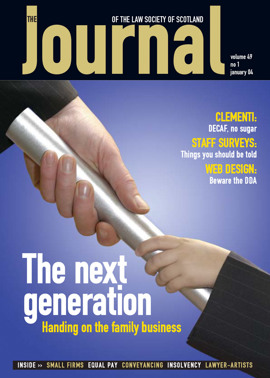Mind the gap
Despite the basic legal requirements under the Equal Pay Act 1970 being in force for so long, there is still much to suggest that they are not being complied with. For example, the New Earnings Survey 2003 (www.statistics.gov.uk) indicates that women who work full time earn 82% of what males working full time earn. Within the legal profession a survey of the profession in England carried out in September 2003 by Legal Business and the Law Society’s Young Solicitors’ Group indicates a pay gap at assistant level with women of 0-2 years’ post-qualifying experience earning 5.1% less than males at that level. That pay gap is said to increase to 15.5% at 6-9 years’ post-qualifying experience.
There are, of course, a variety of theories for the equal pay gap. Some would suggest that the choices that women tend to make and their priorities, play a part with the result that there has been less pressure for equal pay than there might otherwise have been. It is quite possible that the equal pay gap is explained partly by a lack of transparency in pay systems. However those who wish to see equality at work would argue that challenges posed by deep rooted cultural reasons should not be compounded by legal complexities. The law on equal pay has, undoubtedly, been open to criticism on the basis that it is not “user-friendly”. Recently however we have seen developments which attempt to simplify the processes required.
It is a matter of common sense that the very first obstacle an individual may face is obtaining enough information to assess accurately whether or not he or she is receiving equal pay, particularly given the complexities of some pay systems. Last April it became possible for individuals to serve an equal pay questionnaire (http://www.womenandequalityunit.gov.uk/pay/update_question.htm) on their employer. This questionnaire allows the individual to ask his or her employer to disclose details about the pay and benefits of others, even before an equal pay claim is actually presented. Information made available in response to such questionnaires can then be used to substantiate an equal pay claim before an employment tribunal. Although employers will have to balance disclosure of the information against obligations to other individuals whose pay details are being requested and obligations in terms of the Data Protection Act, ignoring the questionnaire or giving an evasive response may well not be an option since employment tribunals are empowered to make adverse findings against the employer in such cases.
An updated Code of Practice on Equal Pay (www.eoc.org.uk/cseng/legislation/law.code.of.practice.pdf), which is the responsibility of the Equal Opportunities Commission, came into force on 1 December last year. It should make informative reading for legal advisers, employees and employers. The Code is not legally binding but it can be referred to in employment tribunal proceedings. The updated Code is split into sections, the first of which gives a clear summary of basic legal requirements related to equal pay. Within that section there is new guidance on the equal pay questionnaire, pregnant women and women on maternity leave, confidentiality and the Data Protection Act 1998. That section also has a commendable summary of the process of an equal pay claim. The second section offers practical guidance to employers on good practice, which is focused on a simple to follow, step-by-step guide to carrying out a voluntary equal pay review. The final section of the updated Code contains a model equal pay policy. Information about other legislation that impacts on pay and a list of useful addresses are annexed to the updated Code.
Finally, there are proposals to simplify the procedures related to equal value claims, which are expected to come into force from 1 October 2004.
Clearly a common thread that runs through all these developments is that equal pay should be made more accessible, whether by encouraging employers to adopt good practice or by making it easier for equal pay claims to be made. This comes against a background of increasing publicity for equal pay. Last year saw a number of very high profile equal pay claims in the City of London. Just prior to Christmas the successful claims of two female solicitors, Sian Herd and Sian Fellows, who were said to have been “blocked” from becoming senior equity partners in their City of London firm, were widely publicised with reports that they will claim compensation in excess of £3 million as a result of the decision (which the firm is said to be appealing). This month the Equal Opportunities Commission launch a new campaign on equal pay, “It’s Time To Get Even”. It would be surprising if the combined effect of legal developments and heightened awareness on equal pay were not to lead to an increase in equal pay challenges. Mind the gap.
Alan Masson, Partner and accredited specialist in employment law, MacRobertsIn this issue
- Wanted: debaters, and reporters
- Small firms: tackling the profit problem
- Who is the family business client?
- Winning your service game
- A near-death experience
- Managing those tensions
- Full strength DECAF
- What should the new Sentencing Commission do?
- A brush with the law
- The truth and the whole truth
- See, hear, speak no html
- Looking back, going forward
- Inhibition on the dependence lives on
- Framework for debt payment takes shape
- Wake up to disability
- Mind the gap
- The new dance called "Electricity"
- Website reviews
- Book reviews
- Conveyancing - not much change in 400 years
- Ironing out settlements and SDLT
- The new law of real burdens
- Housing Improvement Task Force
- Opening the query lines






